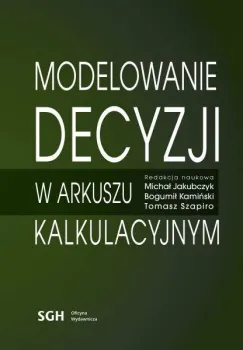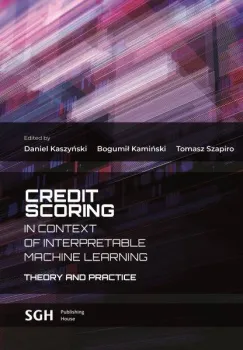Scientific research conducted at the Department of Decision Support and Analysis focuses on the use of quantitative methods to support decision making.
Decision-making methods support decision-makers in the field of economics and management. Today, these methods are a primer for managers and analysts, which have grown out of classical operations research. They have evolved from linear to non-linear optimization, from deterministic problems to uncertainty problems, from process modeling to process simulation, from the use of objective and rigid metrics to interactive methods that allow subjectivism to be taken into account. Until recently, the barrier to the development of these methods was the cost of data collection. Modern methods based on optimization tools and artificial intelligence algorithms, especially data mining tools, allow for full use of the potential of databases collected by enterprises and public institutions.
The Department’s team has many years of experience in cooperation with economic practitioners in the field of decision-making at the level of the entire economy and in many of its selected sectors, including: telecommunications, finance, health care, education, energy, and transport.
The Department conducts research and education using flexible forms of exchange of scientific experience - seminars and workshops adapted to the needs of current projects. The development of the research workshop is possible thanks to active cooperation with foreign research units. This cooperation includes the organization of international scientific conferences and involvement in the work of global scientific associations and journals.
- Members
-
Image

Head of the Unit - prof. dr hab. Bogumił Kamiński
Image
prof. dr hab. Tomasz Szapiro
Image
dr hab. Michał Jakubczyk, prof. SGH
Image
dr Grzegorz Koloch
Image
dr Przemysław Szufel
Image
dr Małgorzata Wrzosek
Image
dr Sebastian Zając
Image
dr Mateusz Zawisza
Image
mgr Marek Antosiewicz
Image
mgr Daniel Kaszyński
Image
mgr Bartosz Pankratz
Image
mgr Łukasz Kraiński
Image
Adjunct professor - prof. Maciek Nowak
Image
Adjunct professor - prof. Krzysztof Postek
Image
Adjunct professor - prof. Paweł Prałat
- Research
-
The subject of scientific work at the Department is modern operational research taking into account modern scientific trends and the needs of practical applications. In particular, we deal with:
- conducting fundamental research formulated in the context of decision analysis (as decision problems), in strong connection with applications and situational background (economic, psychological, organizational and behavioral) based on the obtained grants,
- conducting application work - decision-making consulting, teaching support (case studies, software) based on the results of fundamental research.
The research primarily include the following theoretical trends:
- Decision making theory:
-
modern approaches and extensions of normative and descriptive theories of decision-making by business entities,
-
construction and implementation of multi-criteria procedures in individual and group decision-making and negotiation processes.
-
-
Optimization:
-
theory and applications of global optimization methods, including metaheuristic algorithms and procedures using parallel computing,
-
stochastic optimization,
-
ranking and selection problems.
-
-
Forecasting:
-
using statistical learning theory to support regulatory and managerial decisions,
-
econometric modeling of decision problems.
-
-
Simulation of economic systems:
-
designing and studying the properties of models using discrete event simulation,
-
multi-agent simulations of markets and economies,
-
computational economy models.
-
Theoretical research conducted at the Department is used to solve practical problems in selected sectors of the economy: energy, education, health care, finance, telecommunications, transport and at the macroeconomic level.
- Courses
-
Bachelor studies
Courses
Specializations
Master studies
Courses
Algebra and Mathematical Analysis
Approximation Approaches - from Fourier Analysis to Deep Learning
Specializations
Decision-making Models and Methods
bachelor and masters seminars
The conducted seminars concern economic analyzes supported by mathematical methods and relate to the following trends:
- methods of classical decision analysis and decision support,
- optimization and econometric methods,
- machine learning methods as well as simulation and multi-agent modeling in application to support decision-making in the area of management and economic policy,
- the economics of health and the economics of education and privacy.
- Publications
-
- M. Antosiewicz, A. Nikas, A. Szpor, J. Witajewski-Baltvilks, H. Doukas, “Pathways for the transition of the Polish power sector and associated risks”, Environmental Innovation and Societal Transitions, 35, 271-291, 2020
- A. Nikas., V. Stavrakas, A. Arsenopoulos, H. Doukas, M. Antosiewicz, J. Witajewski-Baltvilks, A. Flamos, “Barriers to and consequences of a solar-based energy transition in Greece”, Environmental Innovation and Societal Transitions, 35, 383-399, 2018
- G. Koloch, B. Kamiński, M. Żbikowski, M. Antosiewicz, “Modelling Heterogeneous Economies-Robustness Vs. Flexibility”, Argumenta Oeconomica, 2 (39), 193-211, 2017
- M. Antosiewicz, P. Lewandowski, ” Labour market Fluctuations in GIPS - shocks vs adjustments”, International Journal of Manpower, 38 (7), 913-939, 2017
- M. Antosiewicz, P. Lewandowski, J. Witajewski-Baltvilks, “Input vs. Output taxation - A DSGE approach to modelling resource decoupling”, Sustainability, 8 (4), 352, 2016
- M. Antosiewicz, “Solving a large heterogeneous-agent general equilibrium model with labour market frictions”, Control and Cybernetics, 45, 2016
- M. Antosiewicz, B. Kamiński, “Agent Rationality Behind Network Formation”, Journal of Organisational Transformation and Social Change, 13 (2), 65-74, 2016
- M. Antosiewicz, G. Koloch, B. Kamiński, “Choice of best possible metaheuristic algorithm for the travelling salesman problem with limited computational time: quality, uncertainty and speed”, Journal of Theoretical and Applied Computer Science, 7 (1), 46-55, 2013
- P. Wojewnik, B. Kamiński, M. Zawisza, M. Antosiewicz, “Social-Network Influence on Telecommunication Customer Attrition”, w: J. O’Shea, N.T., K. Nguyen, R.J. Crockett, L.C. Howlett: “Agent and Multi-Agent Systems: Technologies and Applications”, Lecture Notes in Computer Science 6682, Springer, Heidelberg, 2011
dr hab. Michał Jakubczyk, prof. SGH
- W. Wranik, M. Jakubczyk, K. Drachal, “Ranking the Criteria Used in the Appraisal of Drugs for Reimbursement: A Stated Preferences Elicitation With Health Technology Assessment Stakeholders Across Jurisdictional Contexts”, Value in Health, 23 (4), 471-480, 2020
- M. Jakubczyk, D. Golicki, “Elicitation and Modelling of Imprecise Utility of Health States”, Theory and Decision, 88, 51-71, 2020
- D. Golicki, M. Jakubczyk, K. Graczyk, M. Niewada, “Valuation of EQ-5D-5L Health States in Poland: the First EQ-VT-based Study in Central and Eastern Europe”, Pharmacoeconomics, 37, 1165–1176, 2019
- M. Jakubczyk, BM. Craig, M. Barra, CGM. Groothuis-Oudshoorn, JD. Hartman, E. Huynh, JM. Ramos-Goñi, EA. Stolk, K. Rand, “Choice Defines Value: A Predictive Modeling Competition in Health Preference Research”, Value in Health, 21 (2), 229-238, 2018
- B. Kamiński, M. Jakubczyk, P. Szufel, “A framework for sensitivity analysis of decision trees”, Central European Journal of Operations Research, 26 (1), 135-159, 2018
- M. Jakubczyk, B. Kamiński, “Fuzzy approach to decision analysis with multiple criteria and uncertainty in health technology assessment”, Annals of Operations Research, 251, 301-324, 2017
- M. Jakubczyk, B. Koń, “The impact of firms’ adjustments on the indirect cost of illness”, International Journal of Health Economics and Management, 17 (3), 377-394, 2017
- M. Jakubczyk, D. Golicki, M. Niewada, “The impact of a belief in life after death on health-state preferences: True difference or artifact?”, Quality of Life Research, 25 (12), 2997-3008, 2016
- D. Golicki, M. Jakubczyk, M. Niewada, W. Wrona, J. Busschbach, “Valuation of EQ-5D Health States in Poland: First TTO-based Social Value Set in Central and Eastern Europe”, Value in Health, 13 (2), 289-297, 2010
- M. Jakubczyk, B. Kamiński, “Cost-effectiveness acceptability curves – caveats quantified”, Health Economics, 19 (8), 955-963, 2010
prof. dr hab. Bogumił Kamiński
- B. Kamiński, P. Prałat, F. Théberge, “Artificial Benchmark for Community Detection (ABCD)—Fast random graph model with community structure”, Network Science, 1-26, 2021
- B. Kamiński, P. Prałat, “Train Your Brain - Challenging Yet Elementary Mathematics”, Chapman and Hall/CRC, 2020
- B. Kamiński, V. Poulin, P. Prałat, P. Szufel, F. Théberge, “Clustering via hypergraph modularity”, PLoS ONE 14(11): e0224307, 2019
- K. Growiec, J. Growiec, B. Kamiński, “Social network structure and the trade-off between social utility and economic performance”, Social Networks, 55, 31-46, 2018
- B. Kamiński, M. Jakubczyk, P. Szufel, “A framework for sensitivity analysis of decision trees”, Central European Journal of Operations Research, 26 (1), 135-159, 2018
- M. Aluchna, B. Kamiński, “Ownership structure and company performance: a panel study from Poland, Baltic Journal of Management”, 12 (4), 485-502, 2017
- B. Kamiński, P. Szufel, “On optimization of simulation execution on Amazon EC2 spot market, Simulation Modelling Practice and Theory”, 58, Part 2, 172-187, 2015
- B. Kamiński, “A method for the updating of stochastic kriging metamodels”, European Journal of Operational Research, 247, 859-866, 2015
- B. Kamiński, “Podejście wieloagentowe do modelowania rynków. Metody i zastosowania”, Oficyna Wydawnicza SGH, 2012
- B. Kamiński, M. Zawisza, “Receptury w R. Podręcznik dla ekonomistów”, Oficyna Wydawnicza SGH, 2012
- M. Jakubczyk, B. Kamiński, “Cost-effectiveness acceptability curves – caveats quantified”, Health Economics, 19 (8), 955-963, 2010
- D. Kaszyński, B. Kamiński, T. Szapiro, “Credit Scoring in Context of Interpretable Machine Learning”, SGH Publishing House, 2020
- D. Kaszyński, “Background of the credit scoring”, w: D. Kaszyński, B. Kamiński, T. Szapiro, “Credit Scoring in Context of Interpretable Machine Learning”, SGH Publishing House, 2020
- K. Przanowski, S. Zając, D. Kaszyński, Ł. Opiński, “Variable selection methods”, w: D. Kaszyński, B. Kamiński, T. Szapiro, “Credit Scoring in Context of Interpretable Machine Learning”, SGH Publishing House, 2020
- M. Wrzosek, D. Kaszyński, K. Przanowski, S. Zając, “Selected machine learning methods used for credit scoring”, w: D. Kaszyński, B. Kamiński, T. Szapiro, “Credit Scoring in Context of Interpretable Machine Learning”, SGH Publishing House, 2020
- D. Kaszyński, K. Siuta, B. Kamiński, “Sensitivity of machine learning methods to data issues”, w: D. Kaszyński, B. Kamiński, T. Szapiro, “Credit Scoring in Context of Interpretable Machine Learning”, SGH Publishing House, 2020
- D. Kaszyński, M. Wrzosek, K. Cerazy, “Model performance evaluation and model monitoring”, w: D. Kaszyński, B. Kamiński, T. Szapiro, “Credit Scoring in Context of Interpretable Machine Learning”, SGH Publishing House, 2020
- D. Kaszyński, B. Kamiński, B. Pankratz, “Assessment of the size of VaR backtests for small samples”, Statistical Reviews, 67 (2), 114-151, 2020
- A. Izdebski, T. Słoczyński, A. Bonnier, G. Koloch, K. Kouli, “Landscape change and trade in ancient Greece: evidence from pollen data”. The Economic Journal, 130 (632), 2596 - 2618, 2020
- A. Izdebski A., G. Koloch, T. Słoczyński, M. Tycner, “On the use of palynological data in economic history: New methods and an application to agricultural output in Central Europe, 0–2000 AD”, Explorations in Economic History, 59, 17-39, 2016
- B. Kamiński, G. Koloch (red.), “Advances in Social Simulation, Proceedings of the 9th Conference of the European Social Simulation Association”, Advances in Intelligent Systems and Computing, Vol. 229, Springer, 2013
- M. Brzoza-Brzezina, M. Kolasa, G. Koloch, M. Rubaszek, K. Makarski, “Monetary policy in a non-representative agent economy: A survey”, Journal of Economic Surveys, 27 (4), 641-669, 2013
- M. Bukowski, G. Koloch, P. Lewandowski, “Shocks and rigidities as determinants of CEE labor markets’ performance. A panel SVECM approach”, Economics of Transition, 21 (3), 553-581, 2013
- G. Koloch, T. Szapiro, “Penalty Rules in Multicriteria Genetic Search”, w: „New State of MCDM in the 21st Century. Lecture Notes in Economics and Mathematical Systems” Y. Shi, S. Wang, G. Kou, J. Wallenius (red.), Springer, 648, 91-102, 2011
- G. Koloch, B. Kamiński, “Nested vs. Joint Optimization of Vehicle Routing Problems with Three-dimensional Loading Constraints”, Engineering Letters, 18 (2), 193-198, 2010
- M. Rubaszek, P. Skrzypczyński, G. Koloch, “Forecasting Polish Zloty with Non-Linear Models”, Central European Journal of Economic Modeling and Econometrics, 2 (2), 151-167, 2010
- T. Kuszewski, Ł. Kraiński, “Jednorównaniowy liniowy model ekonometryczny, metoda najmniejszych kwadratów, narzędzie Regresja w programie Excel”, w: M. Jakubczyk, B. Kamiński, T. Szapiro “Modelowanie decyzji w arkuszu kalkulacyjnym”, Oficyna Wydawnicza SGH, 2021
- P. Vavryk, Ł. Kraiński, P. Szufel, M. Łatek, S. M. Rizi, “Forecasting Unemployment Dynamics in Response to COVID-19: A Case Study”, w: B. Kamiński, T. Kuszewski, M. Jakubczyk, “Zagadnienia Wspomagania i Analizy Decyzji”, Oficyna Wydawnicza SGH, 2021
- Ł. Kraiński, “Performance considerations and platforms for scoring models”, w: D. Kaszyński, B. Kamiński, T. Szapiro, “Credit Scoring in Context of Interpretable Machine Learning”, SGH Publishing House, 2020
- B. Kamiński, Ł. Kraiński, A. Mashatan, P. Prałat, P. Szufel, “Multiagent Routing Simulation with Partial Smart Vehicles Penetration”, Journal of Advanced Transportation, 2020, Article ID 3152020, 2020
- D. Wiliński, Ł. Kraiński, K. Wesołowska, M. Duś, S. Marczak, “Wpływ lokalizacji na cenę ofertową nieruchomości na przykładzie ulicy Puławskiej w Warszawie”, Świat Nieruchomości, 3 (101), 69-76, 2017
- T. Szapiro, “Negotiation Process Modelling: From Soft and Tacit to Deliberate”, w: “Handbook of Group Decision and Negotiation”, D. M. Kilgour, C. Eden (red.), 2019
- M. Aluchna, T. Szapiro, “Women on corporate boards: backgrounds, drivers and mechanisms”, w: “Women on boards. An international perspective”, M. Aluchna, G. Aras (red.), Routledge, Abingdon, Oxon, 9-32, 2018
- S. Matwin, J. Nin, M. Sehatkar, T. Szapiro, “A Review of Attribute Disclosure Control”, w: “Advanced Research in Data Privacy” G. Navarro-Arribas, V. Torra (red.), Studies in Computational Intelligence, vol 567. Springer, Cham, 2015
- G. Koloch, T. Szapiro, “Penalty Rules in Multicriteria Genetic Search”, w: „New State of MCDM in the 21st Century. Lecture Notes in Economics and Mathematical Systems” Y. Shi, S. Wang, G. Kou, J. Wallenius (red.), Springer, 648, 91-102, 2011
- S. Matwin, T. Szapiro, “Data privacy: from technology to economics”, w: “Advances in Machine Learning II, Studies in Computational Intelligence”, J. Koronacki, Z. Raś, S. Wierzchoń, J. Kacprzyk (red.), Springer, 263, 43-74, 2010
- B. Kamiński, M. Czupryna, T. Szapiro, “On conditional value-at-risk based goal programming portfolio selection procedure”, w: “Multiobjective programming and goal programming. Lecture Notes in Economics and Mathematical Systems”, V. Barichard, M. Ehrgott, X. Gandibleux, V. T’Kindt (red.), Springer, 618, 243-252, 2009
- W. Michałowski, T. Szapiro, “A Bi-Reference Procedure for Interactive Multiple Criteria Programming”, Operations Research, 40 (2), 247-255, 1992
- S. Matwin, K. Haigh, T. Szapiro, “Genetic Algorithms Approach to a Negotiation Support System”, IEEE Transactions on Systems, Man and Cybernetics, 21 (1), 102-114, 1991
- W. Michałowski, T. Szapiro, “A Procedure for Worst Outcomes Displacement in Multiple, Criteria Decision Making”, Computers and Operations Research, 16 (3), 195-206, 1989
- G. Kersten, T. Szapiro, “Generalized Approach to Modeling Negotiations”, European Journal of Operational Research, 26 (1), 142-149, 1986
- T. Szapiro, “The Calculus of Variations for Multiple Integrals Depending on Higher Order Derivatives”, Annals of Global Analysis and Geometry, 2 (1), 19-54, 1984, praca doktorska.
- K. Gawędzki, T. Szapiro, “On Quantization of Dynamical Groups”, Reports on Mathematical Physics, 6 (3), 477-485, 1974, współautor, rozszerzona praca magisterska.
- C. Spagnuolo, G. Cordasco, P. Szufel, P. Praaat, V. Scarano, B. Kamiński, A. Antelmi, “Analyzing, Exploring, and Visualizing Complex Networks via Hypergraphs using SimpleHypergraphs.jl”, Internet Mathematics, 10.24166/im.01.2020, 2020
- B. Kamiński, Ł. Kraiński, A. Mashatan, P. Prałat, P. Szufel, “Multiagent Routing Simulation with Partial Smart Vehicles Penetration”, Journal of Advanced Transportation, 2020
- B. Kamiński, V. Poulin, P. Prałat, P. Szufel, F. Théberge, “Clustering via hypergraph modularity”, PLoS ONE 14(11): e0224307, 2019
- M. Carillo, G. Cordasco, F. Serrapica, V. Scarano, C. Spagnuolo, P.Szufel, “Distributed simulation optimization and parameter exploration framework for the cloud”, Simulation Modelling Practice and Theory, 83 (1), 108-123, 2018
- B. Kamiński, M. Jakubczyk, P. Szufel, “A framework for sensitivity analysis of decision trees”, Central European Journal of Operations Research, 26 (1), 135-159, 2018
- B. Kamiński, P. Szufel, “On parallel policies for ranking and selection problems”, Journal of Applied Statistics, 49 (5), 1690-1713, 2017
- B. Kamiński, P. Szufel, “On optimization of simulation execution on Amazon EC2 spot market”, Simulation Modelling Practice and Theory, 58 (2), 172-187, 2015
- T. Szapiro, P. Szufel, “Simulated negotiation outcomes through recommendation crowding”, Group Decision and Negotiation, 23 (3), 443-461, 2014
- M. Wrzosek, D. Kaszyński, K. Przanowski, S. Zając, “Selected machine learning methods used for credit scoring”, w: D. Kaszyński, B. Kamiński, T. Szapiro, “Credit Scoring in Context of Interpretable Machine Learning”, SGH Publishing House, 2020
- D. Kaszyński, M. Wrzosek, K. Cerazy, “Model performance evaluation and model monitoring”, w: D. Kaszyński, B. Kamiński, T. Szapiro, “Credit Scoring in Context of Interpretable Machine Learning”, SGH Publishing House, 2020
- M. Giedroyć, K. Bareja, M. Wrzosek, “The predictive power of comprehensive income in Polish companies listed on the Warsaw Stock Exchange”, Zeszyty Teoretyczne Rachunkowości, 105 (161), 113-136, 2019
- J. Kłopotowski, M. Wrzosek, “Zbiór zadań z rachunku prawdopodobieństwa” wyd. poprawione, BEL Studio, 2016
- M. Wrzosek, “Zastosowanie układów dynamicznych do modelowania przepływu informacji na rynku pracy”, Metody ilościowe w Badaniach Ekonomicznych, tom XVI No. 4, 220-229. 2015
- M. Wrzosek, “Model dynamiki rynku pracy z heterogeniczną siłą roboczą”, Metody ilościowe w Badaniach Ekonomicznych, tom XV No. 4, 236-245, 2014
- S. Zając, “Modelowanie dla biznesu. Analityka w czasie rzeczywistym, narzędzia informatyczne i biznesowe”, Oficyna Wydawnicza SGH, 2022
- M. Wrzosek, D. Kaszyński, K. Przanowski, S. Zając, “Selected machine learning methods used for credit scoring”, w: D. Kaszyński, B. Kamiński, T. Szapiro, “Credit Scoring in Context of Interpretable Machine Learning”, SGH Publishing House, 2020
- K. Przanowski, S. Zając, D. Kaszyński, Ł. Opiński, “Variable selection methods”, w: D. Kaszyński, B. Kamiński, T. Szapiro, “Credit Scoring in Context of Interpretable Machine Learning”, SGH Publishing House, 2020
- K. Przanowski, S. Zając, „Modelowanie dla Biznesu. Metody ML, modele portfela consumer finance, modele rekurencyjne analizy przeżycia, modele scoringowe.”, SGH Publishing House, 2020
- B. Dziewit, J. Holeczek, S. Zając, M. Zrałek, “Family Symmetries and Multi Higgs Doublet Models”, Symmetry, 12 (1), 156, 2020
- P. Rubach, S. Zając, B. Jastrzebski, J. I Sulkowska, P. Sułkowski, “Genus for biomolecules”, Nucleic Acids Research, 48 (D1),1129-D1135, 2020
- S. Zając, C. Geary, E. S. Andersen et al., “Genus trace reveals the topological complexity and domain structure of biomolecules”, Nature Scientific Reports 8, 17537, 2018
- P. Chaber, B. Dziewit, J. Holeczek, M. Richter, M. Zrałek, S. Zając, „Lepton masses and mixing in a two-Higgs-doublet model” , Phys. Rev. D 98, 055007, 2018
- E. W. Piotrowski, J. Sładkowski, J. Syska, S. Zając, „The method of the likelihood and the Fisher information in the construction of physical models”, Physics Status Solidi B, 246 (5), 2009
- Modelowanie Decyzji w Arkuszu Kalkulacyjnym
-
Image

The textbook is the result of a synthesis of the authors’ experiences and conclusions from the discussion on the scope of managerial knowledge necessary to function in the modern economy. The book was created with the assumption that its reader will be a person interested in gaining practical skills in solving problems appearing in management and requiring elements of mathematical knowledge. The potential recipient is therefore a student of studies in economics, management sciences, business administration, a novice decision analyst employed in the public or private sector, but also a person with significant experience in the field of management reaching for a new tool in the hope that they will help strengthen analytical skills and support intuition.
The book discusses selected models of decision-making problems that can be encountered in various areas of the company’s operation, as well as tools for more accurate decision-making: tables and decision trees, game theory, optimization, simulation methods, and linear regression models. The presentation of the tools themselves has been supplemented with examples of their implementation in MS Excel, which can be downloaded from this website.
supplementary files
- Credit Scoring in Context of Interpretable Machine Learning
-
Image

Credit scoring assessment, as a result of the Big Data revolution that has been taking place in recent years, is evolving from classical statistical modeling to modern methods based on complex operational research models - Machine Learning methods. The innovative modeling toolkit also poses new challenges related to the procedures for building, validating, monitoring and finally implementing such models and approaches in practice. Economic practice and regulatory requirements of recent years indicate strong trends related to the so-called Trustworthy AI - these are recommendations and guidelines regarding, among others, ways to build interpretable or algorithmically reliable models.
In the book Credit Scoring in the Context of Interpretable Machine Learning, we present modern methods of assessing credit score, preserving the interpretability of the results. Important issues raised in the monograph are the practical use of such solutions: from purely process issues, to modeling approaches, to implementation methods.